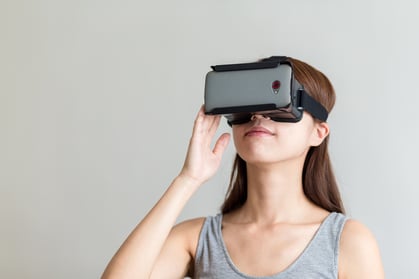How VR and AR are changing the training landscape
%20(2).png)
Immersive learning experiences like virtual reality (VR) and augmented reality (AR) are changing the way training is facilitated. The technology can help training providers create a hands-on, engaging, interactive virtual learning environment all within the safety of a regular classroom.
When you think of augmented or virtual reality, you might think of Pokémon Go or Instagram filters. However, many training companies have started to offer it for skills training in various settings.
Training in AR and VR can not only be faster, safer, and more cost-effective than traditional methods, but delegates are also more likely to remember what they have learned.
Virtual reality (VR) vs. augmented reality (AR)
Despite their similar names, augmented reality is quite different to virtual reality. AR will modify the current surroundings, whereas VR creates a completely new virtual environment.
For example, an Instagram filter (AR) may add a dancing character onto your desk when you point your camera at it, or add face paint onto your selfies. It does not reinvent the environment completely, but adds new visuals (e.g. the dancing character), or augments existing ones (e.g. face paint). AR’s goal is to analyse, understand and develop insight into specific real-world features.
VR creates a simulated experience, creating a completely different environment to the room you're currently in. This is usually done using virtual reality headsets or projectors, generating realistic imagery, sounds and other sensations that simulate your physical presence. Whether you're using a headset or you're in a projected environment, you're able to look and move around, and interact with virtual experiences or items.

Who is using AR and VR in the training industry?
AR and VR is being implemented today for training across several industries, including:
High-risk environments
- BP train their oil refinery and offshore rig workers using VR. In a virtual "production plant", teams can practice anything together from drilling techniques to start-up and emergency shutdown procedures.
- The Royal Navy has used VR technology to sharpen combat skills and techniques.
- UPS has been using VR to train its drivers on safety when making deliveries, teaching them to spot road hazards in their routines.
- Astronauts at Boeing use VR to prepare for spaceflight. The technology allows astronauts to experience their full journey - from pre-launch, to docking and landing – entirely in virtual reality.
Healthcare
- Industries with high compliance standards, such as healthcare, are becoming more welcoming of AR and VR training.
- For example, dentists are trained using AR software built into smart glasses, that superimposes real-time data to help them build precise crowns or caps.
- Nurses are using AR-enabled tablets with simulations of different patient scenarios, to improve their technical, social and team skills.
Corporate training
- Walmart uses more than 17,000 VR headsets to train their employees in three key areas - new technology, soft skills (like empathy and customer service), and compliance. After implementing VR, Walmart saw their employee test scores improve by 10-15%!
“It's incredibly real, so real that you sort of lose all situational awareness of the outside and you're solely focused on the moment that you're in." - Royal Marine
Benefits
It's clear to see that AR and VR are highly regarded in training spaces, earning the trust of companies such as BP, UPS and Walmart. But what are the benefits of using AR and VR as a training provider?
You can train people faster
As it's far more engaging and immersive to train in AR and VR than traditional learning, delegates are more likely to remember what they've learned.
A recent study of how VR can be applied to learning found that delegates who trained using VR were able to learn four times faster than traditional classroom training. Even more impressive - they were four times more focused than the delegates using just eLearning platforms alone. It can be hard to focus on just one screen these days!
It’s a part of a sustainable training strategy
AR and VR can help to improve sustainability within your training. If you're considering your Triple Bottom Line (TBL) - People, Profit, and Planet, using AR and VR can help your business to be more sustainable by:
- Saving on travel-related costs (profit)
- Reducing both trainer's and delegate's carbon footprint in terms of travel and materials used (planet)
- Improving employee engagement and wellbeing by allowing them to train from anywhere, on their own schedule (people)
There's a lower risk of injury, and you can have unlimited goes
On-the-job training in many industries can be quite dangerous - and in some, it simply isn't possible. Whether you're operating million-pound machinery, or working at height on an oil rig, AR and VR provides a safe, effective and scalable way to learn.
AR and VR are a great option for high-risk training environments for a number of reasons. It creates a realistic training scenarios that safely mimic their working environment, get close and see things from a new perspective without risking injury. You can also make as many mistakes as you need to because nothing in your virtual environment (including yourself) can be broken, and you can start over as many times as it takes you to hone your new skills.
It can improve customer experience
Instead of working directly with clients, employees can practice until they have the knowledge and confidence to handle the situation in person. Customers are more likely to listen to and be engaged by a knowledgeable, fully-trained employee, so customer service may run smoother and faster.
Read more: How to make boring training content engaging and fun
It's cost-effective
Traditional training methods can include the use of costly single-use items, and travel is often a part of the training process. AR and VR can help to reduce, or even completely cut these costs altogether. Whilst the initial investment may be expensive, VR headsets can be used across different departments and training programs, which can then be accessed as many times as necessary. Although VR headsets aren't exactly inexpensive, their cost has reduced significantly in recent years since they first hit the mainstream.
Real-time, in-depth analytics
AR and VR software can provide a wealth of real-time data, on a more granular level than traditional training methods. You can visually record the way delegates complete a course, and their reactions to certain situations. It can also help to inform training sessions in the future, helping trainers to understand what is effective and what can be improved in the learner's journey.
"Tell me and I forget, teach me and I may remember, involve me and I learn. " - Benjamin Franklin
Things to consider
Although AR and VR training has so many benefits to both trainers and delegates, there are a few things you may want to consider before starting to use these technologies.
Keep it simple
SynergyXR note that they see many training solutions that fail to utilise the true potential of AR and VR by distracting delegates with gimmicky training. For example, it’s fun to host a training session on Mars, but it doesn’t add any real value and often distracts us from what we're trying to learn.
Another consideration is that AR and VR experiences can quickly become information and experience overload. For many people, it can be too much to handle if they're new to virtual reality. It could lead to sensory overload or even motion sickness.
As AR and VR are effective learning methods - you should really focus on the content. Simple, 3D models of the products/services needed for the training session, alongside any images or videos you're already using.
There's a high initial investment cost
We can't ignore the high initial price tag of AD and VR devices. The most popular VR headsets are around £400, with higher-spec models costing thousands of pounds. Although the price has reduced since VR hit the mainstream, the initial investment could prove costly to your training budget.
Planning and building an AR/VR training experience also requires developer time and setup, adding to the total expense.
It can be difficult to introduce new technology
Adopting and integrating any relatively new technology into your training operations doesn't always go as smoothly as planned, and AR and VR have their own set of technical challenges. However, the constant improvements in headset models and software are beginning to mitigate potential difficulties.
Health side effects
Although AR and VR are a great way to simulate a physical environment, and track precise movements during training, it's still not a complete replica of true reality. Moving around inside a virtual environment can be fun, but it does feel different to real life. For some, this may lead to dizziness and nausea in prolonged AR and VR sessions.
There are of course ways these effects can be reduced, and AR and VR software developers are constantly updating technology to improve the user's experience, to ensure everybody can enjoy training in a virtual environment.
To summarise
Augmented and virtual reality can help both trainers and their delegates to accelerate their learning journey, improve their focus and save time on training. Whilst AR and VR technology may be resource-heavy to implement in the beginning, it has proven to boost effectiveness and efficiency of training sessions, and it used by global companies such as UPS and Walmart to train their workforces.
As more companies implement AR and VR into their training strategies, it may be worth considering how you can apply it to your own training business.
How do I get started?
When looking to adopt AR and VR into your training operations, first consider why and how you'll be using the technology. From there, you can decide on the hardware that would best fit your training. Do further research to build a business case internally to help make a more informed decision.
Whether you hold traditional classroom-style teaching, blended learning, or even AR and VR training, accessplanit's all-in-one training management software is configured to work the way you do. You can forget about admin, and make more time to focus on what matters. Why not book a demo to see how we can help you? 

.png?width=270&height=170&name=choosing%20training%20methodology%20(1).png)
